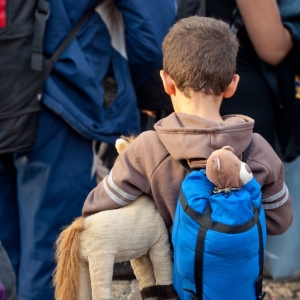Indicators in this domain assess the extent to which migrants have the same status as citizens in terms of access to basic social services such as health, education, and social security. It also describes the rights of migrants to family reunification, to work, and to residency and citizenship. The ratification of the main international conventions is also included within this domain.
Indicators in this category look at the extent to which migrants have access to certain social services such as health, education and social security. They also examine measures to ensure integration and access to work.
Indicators in this domain assess countries’ institutional, legal, and regulatory frameworks related to migration policies. Domain 2 also reviews the existence of national migration strategies that are in-line with development, as well as institutional transparency and coherence in relation to migration management. This domain also investigates the extent to which governments collect and use migration data.
Indicators in this category assess the institutional frameworks of cities for migration. This area also examines the existence of migration strategies consistent with development objectives, as well as institutional transparency and coherence in migration management.
This domain focuses on countries’ efforts to cooperate on migration-related issues with other states and with relevant non-governmental actors, including civil society organizations and the private sector. Cooperation can lead to improvements in governance by aligning and raising standards, increasing dialogue and providing structures to overcome challenges.
Indicators in this category focus on cities’ efforts to cooperate on migration issues with the national government as well as other cities and relevant non-governmental actors, including civil society organizations and the private sector.
This domain includes indicators on countries’ policies for managing the socioeconomic well-being of migrants, through aspects such as the recognition of migrants’ educational and professional qualifications, provisions regulating student migration and the existence of bilateral labour agreements between countries. Indicators equally focus on policies and strategies related to diaspora engagement and migrant remittances.
Indicators in this category assess cities’ initiatives in terms of international student mobility, access to the labour market and decent working conditions for migrant workers. Aspects related to diaspora engagement and migrant remittances are also included in this domain.
This domain studies the type and level of preparedness of countries when they are faced with mobility dimensions of crises, linked to either disasters, the environment and/or conflict. The questions are used to identify the processes in place for nationals and non-nationals both during and after disasters, including whether humanitarian assistance is equally available to migrants as it is to citizens.
Indicators in this category examine the type and level of readiness of cities to deal with aspects of mobility crises. The questions focus on the processes in place for citizens and non-citizens both during and after disasters, especially if humanitarian assistance is available for migrants and citizens.
This domain analyses countries’ approach to migration management in terms of border control and enforcement policies, admission criteria for migrants, preparedness and resilience in the case of significant and unexpected migration flows, as well as the fight against trafficking in human beings and smuggling of migrants. It also assesses efforts and incentives to help integrate returning citizens.
Indicators in this category look at the cities’ approaches to migrant safety as well as return and reintegration policies and the fight against trafficking in persons.
This Profile describes examples of well-developed areas of City of Manaus (Brazil) migration governance structures and areas with potential for further development, as evaluated through the six domains of the Migration Governance Indicators (MGI). These address migrants’ rights, a “whole-of-government” approach, partnerships, socioeconomic well-being of migrants, the mobility dimensions of crises, and safe and orderly migration.
Click the icons on the wheel to explore the key findings.
The Migration Governance Indicators (MGI) initiative is a policy-benchmarking programme led by the International Organization for Migration (IOM) and implemented with research and analysis from the Economist Intelligence Unit. Funding is provided by IOM Member States.
Migration Governance: examples of well-developed areas
- The Manaus Health Secretariat provides free primary health care services to all migrants through 288 Basic Health Units (BHUs). In 2022, a set of specialized BHUs were inaugurated to serve migrants and refugees.
- The Municipal Secretariat of Education of Manaus provides all the necessary guidelines for enrolling and allowing the children of migrants to attend classes, even if they are still in the process of regularization.
- Through EDUMIGRA project (Formação de Professores(as) para a Garantia do Direito à Educação de Crianças e Adolescentes Refugiados e Migrantes), the Secretariat of Education offers distance training to the education sector, with modules that include the context of migration in Brazil, the rights of refugees and migrants, and the challenges they face.
- Migrants and refugees have access to services and information at the Manaus Relocation and Screening Station, the Reception and Support Position at the bus station, and the Interiorization and Transition Position.
Areas with potential for further development
- Establish a local policy or strategy to combat hate crimes, violence, xenophobia, and discrimination against immigrants.
- Provide cultural mediation services to help resolve disputes among migrant populations and between residents and migrants.
Migration Governance: examples of well-developed areas
- The Municipal Committee of Public Policies for Refugees, Migrants and Stateless Persons of Manaus (COMPREMI), created in 2023, is responsible for formulating and coordinating migration policies.
- COMPREMI functions as a local coordination mechanism on migration issues. It is composed of the government, civil society organizations, refugee, migrant and stateless populations, workers, and United Nations agencies.
- Through the Social Assistance Reference Centres and the Specialised Social Assistance Reference Centres, the Municipality of Manaus provides information on the rights and obligations of migrants and on access to local public services.
Areas with potential for further development
- Formulate a migration strategy, defined in a programmatic document, and aligned with local development strategies.
- Create an agency or department responsible for coordinating efforts with diaspora groups.
- Establish vertical policy coherence mechanisms on migration-related issues.
Migration Governance: examples of well-developed areas
- Local authorities collaborate with civil society organizations, the private sector and social partners on issues related to migration through the Municipal Committee of Public Policies for Refugees, Migrants and Stateless Persons of Manaus.
- The Municipality of Manaus actively cooperates with the IOM and other United Nations agencies on migration issues.
- The municipality cooperates with the Federal University of Amazonas to inform migration policies and programs.
- Since 2022, the Municipality of Manaus has been part of the MigraCidades Platform, an initiative that aims to train local actors, promote dialogue on migration, foster peer exchange and certify the government's commitment to improving migration governance.
Areas with potential for further development
- Include formal private sector participation in agenda setting and implementation of migration-related programs.
- Participate in international and bilateral programs to share knowledge and best practices on migration issues.
Migration Governance: examples of well-developed areas
- Local authorities in Manaus implement specific programs, such as the "Monitor de Turismo" (2021), to promote and facilitate the inclusion of migrant workers into the labor market.
- The Municipal Secretariat for Women, Social Assistance and Citizenship of Manaus offers vocational training and language courses for women to promote gender equality for immigrants in the labor market.
- The Municipal Secretariat of Labor, Entrepreneurship and Innovation has programs to support entrepreneurship that are accessible to migrants, and the Manaus Municipal Fund for Entrepreneurship and Innovation provides financing to all local entrepreneurs, including migrants.
Areas with potential for further development
- Conduct assessments at the local level to monitor the demand for migrants in the local labor market or the effects of emigration on the labor market.
- Establish formal programs to promote the ethical recruitment of migrant workers.
- Design strategies and programs at the local level to reduce and monitor the costs of sending and receiving remittances, and to promote the financial inclusion of migrants.
Migration Governance: examples of well-developed areas
- The Executive-Secretariat of Civil Protection and Defense of the Military House of Manaus is responsible for civil protection and defense, including disaster risk management.
- The Municipal Secretariat of Public Security and Social Defense of Manaus, created in 2021, is responsible for disaster management, planning, and promotion of actions to prevent human and natural disasters.
- The Municipality of Manaus has communication systems so that the population can receive information about the evolution of the crisis and access to assistance, as well as communicate their needs to local authorities.
Areas with potential for further development
- Develop an emergency management framework at the local level with specific measures to assist migrants before, during and after crises.
- Establish coordination agreements with key actors to assist migrants during local emergencies.
- Ensure that existing communication systems meet the specific needs of migrants.
Migration Governance: examples of well-developed areas
- Manaus has taken measures to facilitate the arrival of migrant and refugee populations under its jurisdiction through local initiatives developed within the framework of the Federal Program Operation Welcome (Operação Acolhida).
- Manaus has been part of the "Operação Acolhida" internalization strategy process since 2019, and Venezuelan migrants have been received at the operation's reception and screening post since November 2019.
- Manaus actively participates in the planning of refugee resettlement decisions with the Brazilian government.
Areas with potential for further development
- Ensure migrants' access to justice and public safety.
- Regularly train local police on issues related to migrants' rights.
- Strengthen anti-trafficking strategies at local level.




